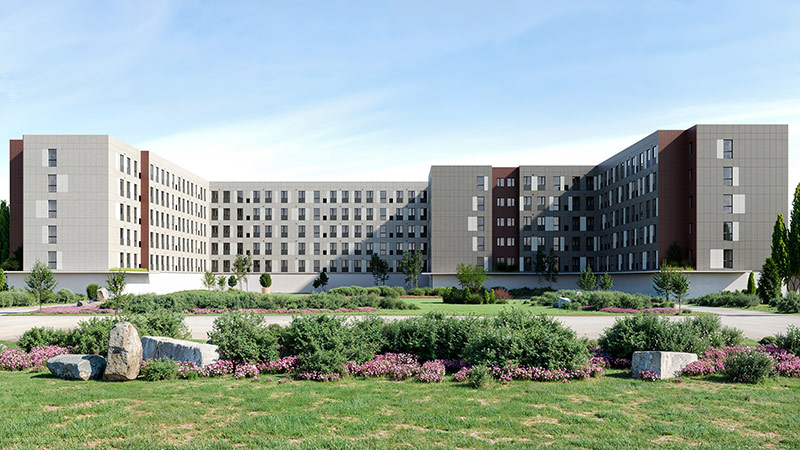Innovating Student Housing with modular construction: Lessons from Volumetric Building Companies
Author: OCRC
Posted on Apr 29, 2025
Category: Off-site Construction
As North America’s post-secondary institutions grapple with housing shortages, rising construction costs, and looming project timelines, off-site solutions like modular construction are rapidly gaining traction. Volumetric Building Companies (VBC), with over 6,000 modules delivered and $3.6B of real estate built globally, is demonstrating how modular methods can deliver faster, smarter, and more sustainable student housing.
In a recent Transforming Construction webinar, Jill Kaehler, former VP of Design, and current Consultant at VBC, and Sam Bailey, VP of Pre-Construction, shared a deep dive into the benefits of modular and what it takes to get it right. Hosted by the Off-site Construction Research Centre (OCRC) in partnership with Building Transformations, the session highlighted VBC’s journey and showcased two successful student housing case studies.
Why modular, Why now?
The building industry hasn’t kept pace with innovation seen in other sectors like automotive or aerospace. But modular is changing that.
VBC’s approach to volumetric modular construction, where entire 3D units are built in factory conditions before being transported to site, offers several advantages:
- Speed: Parallel processing allows site work and module manufacturing to happen simultaneously.
- Certainty: Controlled supply chains reduce delays and budget risks.
- Quality: Factory conditions enable better sealing, insulation, and acoustic performance.
- Sustainability: Less waste, less disruption, and more energy-efficient outcomes.
- Design flexibility: VBC uses a product platform approach with standard interfaces to allow for custom layouts.
It’s VBC’s goal is to make it easier for clients to build better buildings and faster, and modular lets them do that while maintaining quality and predictability.
Case study #1: 789 modules and 1,700+ beds
Location: Within 500 miles of Berwick, PA
Scope: 789 modules across 3 buildings
Objective: Address labour shortages and deliver a higher-quality product
This large-scale undergraduate residence project began with a traditional site-built design. VBC came in at the design development stage to convert the project into a modular layout.
Key design shifts
- Reconfigured modules to group four single rooms into one unit.
- Optimized layouts to reduce module count and improve manufacturability.
- Retained the original footprint, with only minor increases in square footage.
Outcomes
- Modular installation of each building completed in 3 months.
- Over 400,000 sq ft built in a fraction of the time of traditional construction.
- Although overall cost was cost-neutral, the schedule savings created significant financial upside by allowing early occupancy and rental revenue.
Case study #2: 411 modules and 820 beds
Location: Within 300 miles of Berwick, PA
Scope: 411 modules, 820 beds
Objective: Pursue modular from day one to meet budget and timeline goals
Unlike the first project, this one was designed in collaboration with the AOR and VBC for modular from the beginning, with the GC having previous modular experience. The early alignment provided many advantages to the project.
Modular-first design wins
- Consolidated bedrooms and kitchens into modules to improve layout and reduce transportation costs.
- Reorganized the façade and floorplans to improve aesthetics without compromising factory efficiency.
Results
- Achieved a 20% cost savings compared to traditional construction.
- Delivered a full year faster, giving the institution an extra year of operational revenue.
As noted by VBC, “This project showed what’s possible when modular is integrated from the start. The value wasn’t just in speed—it was in quality, cost efficiency, and better design outcomes.”
The secret to success: Early engagement
A recurring theme throughout the webinar was the importance of engaging the modular manufacturer early. Trying to “convert” a conventional project late in the game often leads to missed opportunities and scope gaps. Jill emphasized that even experienced GCs learn something new with each modular build, and the earlier VBC is involved, the more value they can bring.
The takeaway? Don’t think of modular as a bolt-on. It’s a process. One that requires collaboration, shared vocabulary, and a deep understanding of the design-manufacturing-installation workflow.
Thinking modular? Start with a tour
VBC is opening its Berwick, PA factory for tours in May 2025. If you’re considering modular construction for your next student housing project, this is a great chance to see how it all comes together.

Watch the webinar
Missed the session? You can watch the recording and explore more resources from the Transforming Construction Webinar Series, hosted by the OCRC and Building Transformations.
Want to stay in the loop? Email offsiteconstruction@unb.ca to join our mailing list for monthly webinars, case studies and innovative research in off-site construction.

